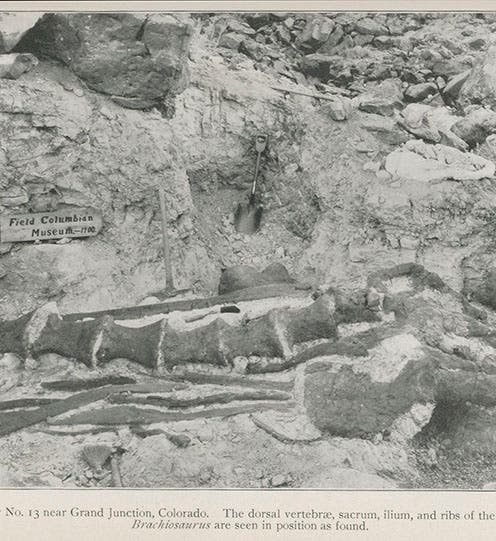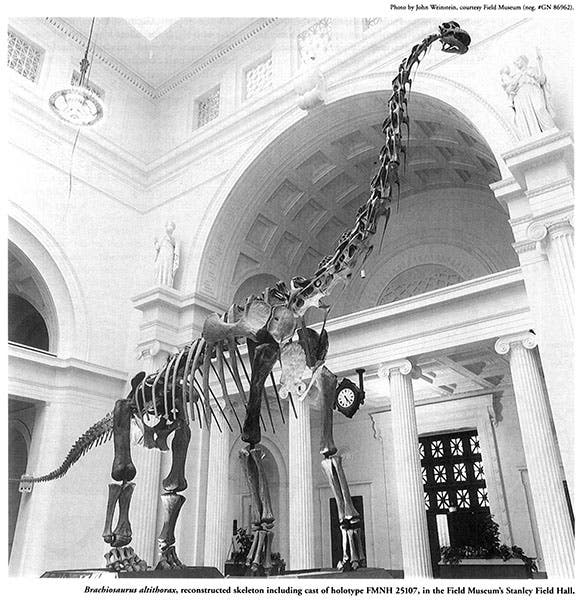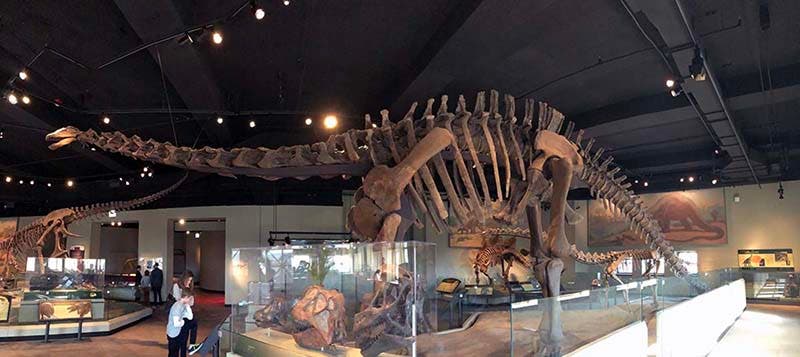Scientist of the Day - Elmer Riggs
Elmer Riggs, an American paleontologist, was born Jan. 23, 1869. In 1898, he joined the Field Columbian Museum of Chicago (now the Field Museum of Natural History), with the assigned task of finding dinosaurs for the collection, even though his specialty was fossil mammals. This was the golden age of sauropod discovery, as the American Museum of Natural History in New York, that very year, was finding their first Brontosaurus, and the Carnegie Museum of Pittsburg was joining the feeding frenzy, digging up the first Diplodocus. Riggs found a suitable site near Grand Junction, Colorado, and there, in 1900, his assistant H. William Menke discovered a partial skeleton of a new sauropod genus (first image). The dinosaur had an odd anatomical feature for sauropods: its humerus (upper front leg bone) was longer than its femur (thigh bone). The partial skeleton was excavated, the bones were encased in plaster, and everything was brought back to Chicago for study. The Field Museum archives has a photograph of Riggs and Menke in the paleontology lab of the museum, with the 2-meter-long humerus still wrapped in plaster at the left (second image)
In 1903, Riggs described the new dinosaur and named it Brachiosaurus (arm-lizard), with a species name: altithorax (deep-chested). The paper was published in the venerable American Journal of Science, which had published Marsh’s earlier papers on Apatosaurus and Brontosaurus, and included a scale drawing of the soon-to-be famous humerus (third and fourth images).
In 1910, a similar dinosaur skeleton, much more complete, was discovered in East Africa and taken back to Berlin. It was named Brachiosaurus brancai, and it had enough bones, combined with those of Riggs, to allow a reconstruction on paper of a Brachiosaurus. But it was not until 1993 that the Museum attempted a physical reconstruction of their famous specimen. The skeleton was made out of resin, but they used casts of the actual bones found by Riggs, supplemented by sculpted replicas of the Berlin bones (fifth image).
This was a majestic mount, even if they added several vertebrae to make it wide enough to walk under and otherwise deformed the mount for safety reasons. I saw the Riggs Brachiosaurus in place in the 1990s and was mesmerized, even though I knew there was not a real bone in it. Sadly, in 2000, they removed the skeleton to make room for "Sue," their new Tyrannosaurus – a bone-headed decision, in my opinion. You can see T-rexes anywhere, but in what other museum can you see a 40-foot tall Brachiosaurus? Until recently, only in Berlin, but since their specimen was renamed Gigantosaurus some time back, the answer now is: nowhere. Field Museum officials shuffled their evicted Brachiosaurus skeleton off to O'Hare airport, where you can still see it, sadly out of place. A new replica was constructed, and it now stands outside the museum. It doesn't move me like the old indoor version.
We now return to Elmer Riggs and the early years of the century. In 1901, the Museum acquired its first Apatosaurus, a sauropod that had been discovered back in 1877 by Othniel C. Marsh, just 2 years before he found his more famous Brontosaurus. The Field Museum specimen was found by Riggs and Menke at a site near Fruita, Colorado. We show here a photo of the specimen in situ, along with a beautiful drawing of part of the vertebral column after it had been excavated and cleaned; both are from a paper Riggs published in a Field Columbian Museum journal in 1903 (sixth and seventh images).
Riggs studied the Apatosaurus fossils, and compared them with the Brontosaurus specimens, and decided there was no justification for placing them in different genera. Since Apatosaurus was found first, Riggs advised that Brontosaurus excelsus should be named Apatosaurus excelsus. No one paid any attention for some time, but later specialists eventually decided that Riggs was right and renamed their specimens. The public refused to let go of Brontosaurus (indeed, "thunder-lizard" is hard to beat as a sauropod name), and Stephen Jay Gould wrote a column, and later a book, Bully for Brontosaurus, arguing that the public was right in this case. The argument went on until 2015, when several sauropod experts reconsidered and decided that there was justification after all for separating Apatosaurus and Brontosaurus, and sanctioned a return to the name Brontosaurus excelsus. The same authorities placed the Field Museum Apatosaurus in limbo, declaring it a “Diplodocidae indeterminate”, meaning they don’t know just what it is, but it is not Apatosaurus. Somewhere, Elmer Riggs is rolling his eyes, or perhaps he is just twirling his thumbs, biding his time until the next taxonomic revision.
Dr. William B. Ashworth, Jr., Consultant for the History of Science, Linda Hall Library and Associate Professor emeritus, Department of History, University of Missouri-Kansas City. Comments or corrections are welcome; please direct to ashworthw@umkc.edu.












